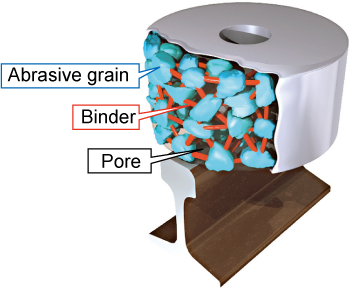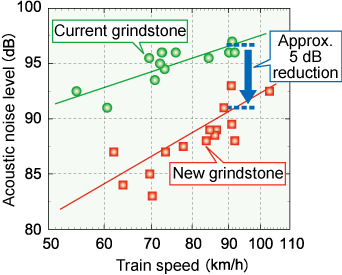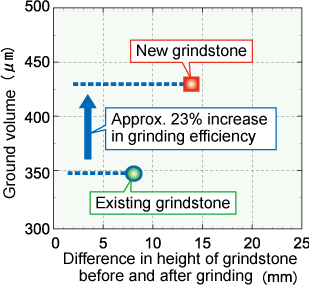3. Dual action rail grinding stone with improved grinding action and reduced grinding trace
- A new rail grinding stone was developed with a different type and size of abrasive grain and bonding strength.
- Confirmation was obtained that the new grinding stone produces less trace and has higher grinding efficiency.
Squats are controlled and corrugation eliminated through abrasion of the rail surface with a grindstone in a process called “rail grinding”. There is a continuous effort being made to reduce the trace left on the rail after grinding which is a source of acoustic rolling noise.
Research to date has focused mainly on adjusting the speed of rail grinding vehicles or the angle of the grindstone during abrasion, whereas the grindstone itself has received little attention. As such, the present research concentrated on developing a new grindstone which could address the abovementioned issues.
Grindstones basically consist of three elements: abrasive grain, binding material and pores. The performance of the grindstone is adapted to the requirements of the work in question by adjusting these three elements as appropriate. In the new design, the blend ratio of two types of abrasive grain used in the grindstone was modified and grain size was increased to improve grinding efficiency. The binding material was also changed accelerating wear of the abrasive grains themselves in order to reduce the trace left by grinding. In-line trials on actual track utilizing grinding machines mounted with the new grindstone demonstrated that the modified design not only restrained the grinding trace and reduced acoustic rolling noise by approximately 5dB (Fig 2), but also improved grinding efficiency by about 23% (Fig 3). Furthermore, the cost for the new grindstone is estimated to be more or less the same as for existing design.
 Fig. 1 schematic diagram of grindstone composition
Fig. 1 schematic diagram of grindstone composition Fig. 2 Acoustic rolling noise after grinding
Fig. 2 Acoustic rolling noise after grinding Fig. 3 Grinding capability of new design and existing grindstones
Fig. 3 Grinding capability of new design and existing grindstones